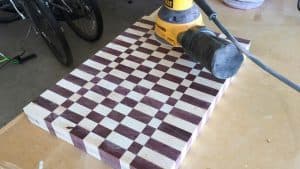Most orders for IN STOCK items placed by 12PM CST M-F ship SAME DAY. Orders for custom items and prints may take additional time to process.
Honestly, that’s not too far from my story. Fortunately for me I was taught about end-grain dangers from my shop teacher some 30 years ago in high school. For many, the next step that follows for most people is to run the finished cutting board through the planer end-grain up, in many cases to disastrous results!
The most common end-grain item that a new woodworker is most likely to attempt to run through the planer is an end-grain cutting board. It’s an extremely common new woodworker project and without any thought behind it (and why? it seems perfectly reasonable on the surface) it goes right into the planer; end-grain up.
 Wood is fibrous. The fibers are what make up the grain of the board. End-grain is basically where all of the fibers end. Think of the end of a board like the end of a brush with the bristles sticking up. Have you ever tried sanding the end-grain in your projects? Have you notice how much more difficult it is to get end-grain smooth? This is the same reason there are different blades for rip cutting and cross cutting. Different orientations of the grain behave differently. Cutting end-grain is much tougher on your blades. If you send end-grain through the planer it stands a very likely chance of the board fracturing and your planer ejecting the board and very high materials. This is an extremely dangerous situation that you do no want to be around when it goes off.
Wood is fibrous. The fibers are what make up the grain of the board. End-grain is basically where all of the fibers end. Think of the end of a board like the end of a brush with the bristles sticking up. Have you ever tried sanding the end-grain in your projects? Have you notice how much more difficult it is to get end-grain smooth? This is the same reason there are different blades for rip cutting and cross cutting. Different orientations of the grain behave differently. Cutting end-grain is much tougher on your blades. If you send end-grain through the planer it stands a very likely chance of the board fracturing and your planer ejecting the board and very high materials. This is an extremely dangerous situation that you do no want to be around when it goes off.
A few years ago I was watching this guy on YouTube called “mtmwood” run cutting board after cutting board through his planer. So I thought “If he can do it, then so can I!” I proceeded to run my just finished end-grain board through the planer. I used rails on the front and back, just like he does. Within seconds into the cut I hear very loud banging and popping as my cutting board is ejected in 5 separate pieces from the planer. My planer continued to buck like a bronco afterwards until I could shut it off. A new set of blades later and lot of pride lost I was back in business.
Yes they do! And there’s also some disaster videos of it on YouTube too. Having seen those videos and experiencing it myself, I have to say “Just Don’t!” It’s not worth the risk. Some people are luckier than others. You never know when your luck will run out. Get a drum sander. That’s the safe way.
Here’s a couple of examples of what can go wrong.
If you like our content maybe consider upgrading to Premium. You’ll get access to
8 Responses
I run endgrain through the planer all the time. Never heard of it being a problem and I don’t plan to stop. I don’t believe you.
Hey… some people also think smoking is safe. Best of luck to you.
It is perfectly safe as long as you know what you’re doing. If you don’t, then you should definitely stay away from it. One method is to attach a side grain piece of sacrificial scrap to the leading and trailing edges of the end grain boards going through the planer. Also, if it isn’t already obvious, be sure to make very shallow passes.
I looked at the video and I think it is miss-named as an end grain chess board. It is made of strips of wood with the end grain on the glued side not the visible side. In cooking terms it is a slicing board not a chopping board.
I’ve done it a few times as well with very shallow passes, it works but not worth it because anything could’ve gone wrong at any moment!
I am new to this. Is it safer with a helical head planer and very shallow cuts? I don’t have a drum sander but it is on my wish list. Thanks Gary
I actually cut my thumb off when trying to pass a huge endgrain block on my planer. I am missing the tip of my finger.. I encourage anyone to not do this mistake.
I’ve achieved beautiful results when running end grain wood through my planer. There are several “rules” that I follow though.
*The planer blades MUST be sharp. Replace or flip them if necessary.
*Don’t plane end grain boards that are thin. I wouldn’t plane anything less than 1.5 inches thick.
*Take extremely light passes. I usually limit my passes to .006-.007″
*Attach a sacrificial strip of wood on both ends to eliminate chip out of the edges.